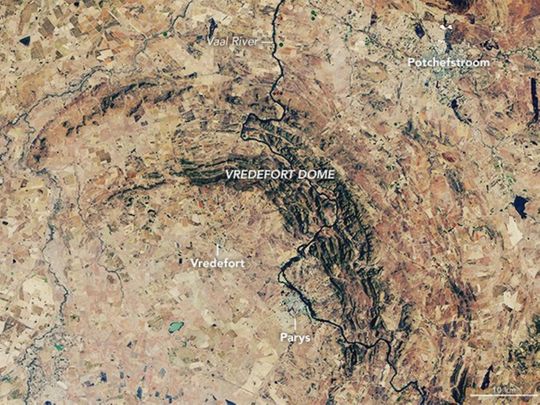
Around 2 billion years ago, an asteroid crashed near present-day Johannesburg to carve out what is now the world's largest known crater. The impact initially put a dent in Earth's surface that spanned 60 miles wide, but the crater grew up to three times wider as its walls collapsed and the rocks below began to rebound. Scientists say the impact was larger and more energetic than the one that killed the dinosaurs.
Today, the Vredefort crater looks nothing like its bowl shape during its formation and certainly not the site of a catastrophic global event. Heavy erosion has left only a portion of its ring still discernible. Parts of the crater even include farmland. Yet even finding that amount of evidence from this crater is lucky, scientists say.
A new study found that Earth's oldest craters, which can hold clues to how life persisted on our early planet, are disappearing - and there's not much we can do about it. The study estimates that because of natural erosion, craters older than 2 billion years are probably indistinguishable from other non-crater rocks.
Take the Vredefort crater. If the impact event had occurred 200 million years earlier, then erosion processes would have wiped out the crater by now, according to the new research. To scientists today, it would have looked like the asteroid never hit.
"It's not so much that Vredefort is disappearing. It's that all of its cousins have disappeared," said Matthew S. Huber, lead author of the study. "It's fortuitous that we have the amount of evidence for Vredefort that we do."
A 2-billion-year-old crater may sound ancient, but that only accounts for half of Earth's history. Cratering has occurred since the beginning of the solar system, appearing on the surface of many rocky bodies. Geologists have counted around 200 impact craters on Earth's surface, with the oldest around 200 billion years ago. But Huber said there should be a lot more.
"We're aware that very large impact events must have occurred because we have the products that were formed by them," Huber said. "Any of those structures that may have once existed are just eroded away . . . If we can't find it, then it doesn't exist effectively."
So Huber and his colleagues wanted to know: When does erosion cause a crater to stop being a crater?
To answer that question, the researchers dug into the 190-mile-wide Vredefort crater. At the time of impact, the surge of energy caused the crust and mantle to rise, leaving a dome and bull's-eye in the middle. Ridges of rocks peaked further away from the center. The heat melted rocks and transformed minerals.
Scientists study these melted rocks, altered minerals and other products to learn more about our solar system and the origins of certain life forms. Sometimes, Huber said, the heat after an impact can create an environment where life can grow. Or the crater rocks could provide clues to the amount of energy released during an impact, which can sometimes be enough to cause an extinction (think dinosaurs).
But over the past 2 billion years, erosion shaved down about six miles of the crater from its surface. Huber wanted to see if rocks at this depth still showed geophysical signs of the impact event, such as different density and porosity.
The team sampled rock cores across a 14-mile transect, comparing the physical properties of these crater rocks with non-impacted rocks. They also created a model of the impact event and compared their samples with what the model showed should happen to the physical properties of rocks.
The results were shocking, and not in a good way. They found that the rocks were indistinguishable from those that had never experienced an asteroid shock. The porosity, density and speed at which a sound wave moves through the rock, for instance, were identical to un-shocked rocks.
"If we buried those rocks and we only encountered them in a drill core, for example, then it's a very good chance that nobody would even recognize that it was an impact," Huber said. "At some point, we lose all of the features that make the crater a crater."
Think of it like a wedding cake. The icing and topper is a signature mark of the cake, but once they are stripped, the remaining sponge cake is indistinguishable from any other sponge cake. It's no longer clear what it once was.
Marine geologist Ted Moore, who was not involved in the research, said the study's explanation on the mysterious lack of older craters is "spot on." He added that the most effective erosional mechanisms is the grinding action of from ice sheets flowing on land - and ice covered most, if not all, continents during past ice ages.
Additionally, Moore, a professor at University of Michigan, pointed out that an asteroid impact could also be hidden by our oceans, which cover more than 70 percent of our planet. As the size of the oceans and continents changed through Earth's evolution, some of these changes may have partially masked some identifiable craters.
"This study shows that a large portion of the geological history of our planets is probably lost forever by being recycled by our extremely active planet," said Ania Losiak, a planetary scientist at the Polish Academy of Sciences's Institute of Geological Sciences who was not involved in the research. Losiak attended graduate school with Huber.
Yet learning about Earth's early history hasn't completely disappeared. Losiak emphasized that scientists can study other planetary bodies, like the moon, where similar gigantic impact craters have been less affected by erosion.
For the hopeful scientists out there, there's also serendipity that perhaps one will get lucky and find an unusually well-preserved crater on Earth.
"We keep looking [for new structures] because there can always be something anomalous and something weird that's around," Huber said.Ancient craters teach us Earth's history, but scientists can't find them












